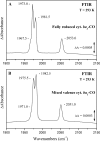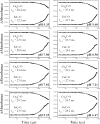Spectroscopic and kinetic investigation of the fully reduced and mixed valence states of ba3-cytochrome c oxidase from Thermus thermophilus: a Fourier transform infrared (FTIR) and time-resolved step-scan FTIR study
- PMID: 22927441
- PMCID: PMC3481344
- DOI: 10.1074/jbc.M112.403600
Spectroscopic and kinetic investigation of the fully reduced and mixed valence states of ba3-cytochrome c oxidase from Thermus thermophilus: a Fourier transform infrared (FTIR) and time-resolved step-scan FTIR study
Abstract
The complete understanding of a molecular mechanism of action requires the thermodynamic and kinetic characterization of different states and intermediates. Cytochrome c oxidase reduces O(2) to H(2)O, a reaction coupled to proton translocation across the membrane. Therefore, it is necessary to undertake a thorough characterization of the reduced form of the enzyme and the determination of the electron transfer processes and pathways between the redox-active centers. In this study Fourier transform infrared (FTIR) and time-resolved step-scan FTIR spectroscopy have been applied to study the fully reduced and mixed valence states of cytochrome ba(3) from Thermus thermophilus. We used as probe carbon monoxide (CO) to characterize both thermodynamically and kinetically the cytochrome ba(3)-CO complex in the 5.25-10.10 pH/pD range and to study the reverse intramolecular electron transfer initiated by the photolysis of CO in the two-electron reduced form. The time-resolved step-scan FTIR data revealed no pH/pD dependence in both the decay of the transient Cu(B)(1+)-CO complex and rebinding to heme a(3) rates, suggesting that no structural change takes place in the vicinity of the binuclear center. Surprisingly, photodissociation of CO from the mixed valence form of the enzyme does not lead to reverse electron transfer from the reduced heme a(3) to the oxidized low-spin heme b, as observed in all the other aa(3) and bo(3) oxidases previously examined. The heme b-heme a(3) electron transfer is guaranteed, and therefore, there is no need for structural rearrangements and complex synchronized cooperativities. Comparison among the available structures of ba(3)- and aa(3)-cytochrome c oxidases identifies possible active pathways involved in the electron transfer processes and key structural elements that contribute to the different behavior observed in cytochrome ba(3).
Figures










Similar articles
-
Discrete Ligand Binding and Electron Transfer Properties of ba3-Cytochrome c Oxidase from Thermus thermophilus: Evolutionary Adaption to Low Oxygen and High Temperature Environments.Acc Chem Res. 2019 May 21;52(5):1380-1390. doi: 10.1021/acs.accounts.9b00052. Epub 2019 Apr 25. Acc Chem Res. 2019. PMID: 31021078
-
Structural changes that occur upon photolysis of the Fe(II)(a3)-CO complex in the cytochrome ba(3)-oxidase of Thermus thermophilus: a combined X-ray crystallographic and infrared spectral study demonstrates CO binding to Cu(B).Biochim Biophys Acta. 2012 Apr;1817(4):658-65. doi: 10.1016/j.bbabio.2011.12.010. Epub 2011 Dec 27. Biochim Biophys Acta. 2012. PMID: 22226917 Free PMC article.
-
Observation of ligand transfer in ba3 oxidase from Thermus thermophilus: simultaneous FTIR detection of photolabile heme a3(2+)-CN and transient Cu(B)(2+)-CN complexes.J Phys Chem B. 2012 Aug 2;116(30):8955-60. doi: 10.1021/jp305096y. Epub 2012 Jul 20. J Phys Chem B. 2012. PMID: 22765881
-
Time-resolved step-scan Fourier transform infrared investigation of heme-copper oxidases: implications for O2 input and H2O/H+ output channels.Biochim Biophys Acta. 2004 Apr 12;1655(1-3):347-52. doi: 10.1016/j.bbabio.2003.06.004. Biochim Biophys Acta. 2004. PMID: 15100050 Review.
-
FTIR studies of internal proton transfer reactions linked to inter-heme electron transfer in bovine cytochrome c oxidase.Biochim Biophys Acta. 2004 Apr 12;1655(1-3):321-31. doi: 10.1016/j.bbabio.2004.01.007. Biochim Biophys Acta. 2004. PMID: 15100047 Review.
Cited by
-
Proton Pumping and Non-Pumping Terminal Respiratory Oxidases: Active Sites Intermediates of These Molecular Machines and Their Derivatives.Int J Mol Sci. 2021 Oct 7;22(19):10852. doi: 10.3390/ijms221910852. Int J Mol Sci. 2021. PMID: 34639193 Free PMC article. Review.
-
ns-μs Time-Resolved Step-Scan FTIR of ba₃ Oxidoreductase from Thermus thermophilus: Protonic Connectivity of w941-w946-w927.Int J Mol Sci. 2016 Sep 29;17(10):1657. doi: 10.3390/ijms17101657. Int J Mol Sci. 2016. PMID: 27690021 Free PMC article.
-
The Reactions of O2 and NO with Mixed-Valence ba3 Cytochrome c Oxidase from Thermus thermophilus.Biophys J. 2020 Jan 21;118(2):386-395. doi: 10.1016/j.bpj.2019.11.3390. Epub 2019 Dec 6. Biophys J. 2020. PMID: 31870538 Free PMC article.
-
Light-based therapy of infected wounds: a review of dose considerations for photodynamic microbial inactivation and photobiomodulation.J Biomed Opt. 2025 Mar;30(3):030901. doi: 10.1117/1.JBO.30.3.030901. Epub 2025 Feb 7. J Biomed Opt. 2025. PMID: 39925694 Free PMC article. Review.
References
-
- Marcus R. A., Sutin N. (1985) Electron transfers in chemistry and biology. Biochim. Biophys. Acta 811, 265–322
-
- Page C. C., Moser C. C., Chen X., Dutton P. L. (1999) Natural engineering principles of electron tunneling in biological oxidation-reduction. Nature 402, 47–52 - PubMed
-
- Page C. C., Moser C. C., Dutton P. L. (2003) Mechanism for electron transfer within and between proteins. Curr. Opin. Chem. Biol. 7, 551–556 - PubMed
-
- Moser C. C., Page C. C., Farid R., Dutton P. L. (1995) Biological electron transfer. J. Bioenerg. Biomembr. 27, 263–274 - PubMed
MeSH terms
Substances
LinkOut - more resources
Full Text Sources

